From Anza-Borrego to Big Sur
 |
|---|
I. My Idiot Ramble
Do you ever have one of those days when everything seems to come together? Yesterday I had one, and it reminded me that “everything” can sometimes turn out to be “not much,” though it's hardly less appealing for that.
The chain of events—not really a chain, let's dismiss that dismal image—was as follows: I had been working on the layout of a book all morning. A friend suggested that we catch an afternoon matinee of a four-hour film about the last days of Hitler. (See FILMS) But it was a beautiful spring day, and I declined, preferring to take a stroll around one of the lakes with which Minneapolis is inordinately blessed.
The ice was going out. This is a thrilling moment unfamiliar to residents of warmer states. You see the ice, rather gray and unsure of itself, having retreated ten feet or more from the rocky bank. You wonder how thick it is. In fact, you're almost tempted to drift out on a chuck that's detached itself from the mass and drifted ashore. On those larger stretches of open water that have developed here and there you stop to listen to the tinkling of the broken shards of ice, one against the other, in a kind of Pythagorean symphony that Strindberg might have enjoyed. You ponder the inky depths beneath the ice, which seem more interesting with a roof over them than they will once the ice is gone. Perhaps an unusual grebe will appear out in the open water, or even an errant oldsquaw—but not yet. It's too early. Today the hot sun on the face is enough.
After my three-mile stroll around the lake, I returned to the car, did a U-turn on Calhoun Parkway, and drove to Lund's to pick up some orange juice. Once I'd made my purchase—having endured an “express” cashier who performed every function, from opening the brown paper bag to swiping the credit card, with the slow and infuriating grandeur of a ballerina—I walked up the street to CD Now, with the idea in mind of picking up the most recent issue of Minneapolis Observer . They didn't have that brilliant magazine, but in the international bin, in the midst of a very limited selection, I was pleased to find a recent recording by the Finnish accordionist Maria Kalaniemi, which I purchased without the slightest hesitation.
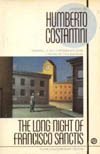 |
|---|
At this point, feeling that I'd outworn my welcome in the Lunds parking lot, I pulled out and found a meter a block up the street. The afternoon was so warm that I left my jacket in the car and walked with new-found freedom and ease to a used book store a block and a half away. In the bargain bin outside the shop my eye caught sight of a book with the clever title Medieval American Art . An apparent contradiction, the book was in fact a large and handsome exposé of pre-Columbian art. At the price of $2, how could I resist? On the other side of the cart I found a novel by an Argentine fellow named Humberto Costantini, enthusiastically endorsed on the back cover by Julio Cotrázar. Worth a dollar? Who knows, it might change my life! Inside the shop I found the magazine I was looking for, and also the most recent issue of RainTaxi. I snagged both magazines, made my other two purchases, and returned to the car.
The Uptown neighborhood is filled with young people who would not be impressed if you told them you remember when THAT corner was the location of a dismal Save Mart, or when the building across the street, now the home of a Gap, was the site of a store called Mr. Fashion, where you sometimes purchased your Levis. Nor would they take interest if they happened to catch a wiff of that CD of Stan Getz and Chet Baker (Stockholm, 1984) blaring from your CD player. And why should we care? After all, experience is the reward for having lived, and no one is as cool as we are, except, perhaps, Alfred E. Newman or Meyer Baba. (This is the message of the Buddha to us all.)
Having enjoyed a small part of the sunny afternoon, and the expansive, leisurely frame of mind that invariably develops during even a few minutes spent on the sidewalk in front of a cart of very inexpensive books, I returned to my 1992 Toyota Tercel (42 mpg) and made my way back around the lakes and up the parkway to my house.
I was pleased to see a new Daedalus catalogue waiting for me in the mail when I reached home. After availing myself of a post-Easter hard-boiled egg from the refrigerator, (dyed deep red in the Greek style), I wandered over to the sliding doors leading out onto the deck, where an entire world had been slowly returning to life, day after day, before my eyes. The recent rains had obliterated the final layer of late-winter snow-dirt, and it was clear that the earth was finally breathing again. Looking out through the glass, I immediately spotted a fox sparrow vigorously raking through the leaves at the base of the spruce tree with his feet, then bending forward to nab whatever he happened to unearth with his beak.
 |
|---|
The fox sparrow is a wonderful bird. There are times when I think he must be the finest sparrow. His song can't match the plaintive whistle of the white-throated sparrow, or the faint descending trill of the distant field sparrow; and his markings are less elegant and dramatic than those of the lark sparrow, less pure than the natty black, gray and white headdress of the white-crowned sparrow. But the fox sparrow has personality . Larger than most sparrows, and with chest coloring more typical of the thrushes, he moves swiftly, proudly, and assertively through the underbrush, exploring the life on the forest floor. You can almost hear him thinking, “If I had hands, this would be a lot easier,” as he hops back and forth scraping forcefully through the underbrush.
Later that evening, after an easy meal of chicken breasts simmered in a jar of Indian spinach sauce, and then dumped on top of a heap of reheated cous-cous, we sat in the back room watching the light disappear from the sky—an event that will be less dramatic once the leaves fill in on the trees—and listened to the odd and haunting tunes that Maria Kalaniemi and her Swedish collaborator, the violinist Sven Ahlbäck, were spinning. Nature music, definitely. The irregular, halting, and difficult rhythms; the remarkable plaintive purity that issues from the accordion reeds, which modern hi-fi technology brings to life in your den with staggering richness. When Kalaniemi and her cohort had reached the end of their performance, we started it up all over again.
II. California, Finally
Winter isn't a bad time, though it tends to wear you down. In recent years Hilary and I have made several visits to the West Coast in February to see an old friend, and also to take in a little bit of the countryside. Betty Sword has lived in Pasadena for at least twenty years. She moved out to accompany her husband Greg, who'd received a fellowship to study at Cal Tech. He later received a offer from an Australian University, but Betty had gotten an interesting job at Jet Propulsion Laboratory (JPL) by that time, and she chose to stay behind.
We got to know Betty during her years in Minneapolis, when she and Greg lived across the park from us. In those days we'd go birding together, split bulk purchases of olive oil, and attend films at the nearby Uptown theater—though Greg would invariably adopt a bizarre Marxist rationale for endorsing films no one else liked—Kubrick's The Shining, for example. Since the move to California Betty had been back to the Cities once or twice, but aside from a stray email or Christmas card now and then, we hadn't done a very good job of keeping in touch, and it was fun to reconnect.
On our visit a year ago, we spent an entire morning at JPL, where Betty's friend Ben gave us a grand tour of the facilities. At that time Ben was in charge of directing the crew that actually directed the rovers across the surface of Mars on a daily basis. An elite team of scientists was also meeting daily to determine which projects were to be pursued, and then directing Ben on how to direct his team. But aside from one spectacular loss of communication on the second or third day after the landing, everything was going very well, and most of the people we met up with seemed to be having a good time, notwithstanding the fact that a Martian day is longer than an earth day, and the various teams of scientists and technicians were gradually creeping from day shifts to night shifts as the two diurnal cycles drifted further and further apart.
Ben showed us a large room where the small portion of surface of Mars had been re-created, so that a second rover, identical to the one that had landed on the Red Planet, could be tested in various maneuvers before the Martian one was given its instructions. We toured the room where launches are controlled and monitored. It looked very familiar, perhaps because it's often used as a set by nearby film studios when the NASA folks aren't using it.
Yes, everything was going well with the Mars project... yet very little had been discovered at that time to indicate that water had ever been present on the surface of the planet. Ben showed us images of some round beads of stone that some scientists found encouraging....
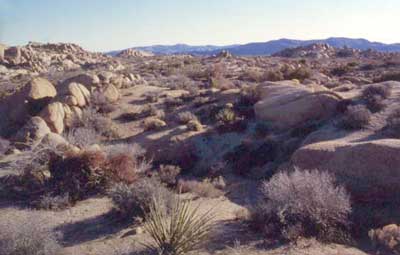 |
|---|
The next morning we drove out with Betty to spend three days camping in the desert at Joshua Tree National Park. The views to the west toward the San Gabriel Mountains were spectacular, and the boulder-fields in the central part of the park were intriguing. On a late afternoon hike, with dark clouds rolling in, we decided to cut cross-country back to the campsite. We hadn't been going in quite the direction I'd imagined, however, and as evening descended all the hills started to look alike. I finally came upon some footprints in a wash, and once we'd plodded upstream in the sand for a few hundred yards the faint smell of frying bacon greeted our nostrils. By that time I had begun to think sober thoughts like “Well, it wouldn't kill us to spend a night out in the desert,” but all the same, it was a relief to find our way back to civilization. We ate a cold dinner and drank a bottle of wine in the car, laughing at our recent adventure, and Hilary admitted that at one point Betty had said to her tentatively, “Now, how good is John's sense of direction?”
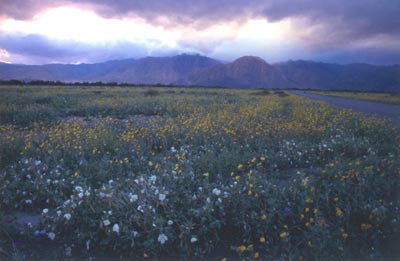 |
|---|
This February we returned to the West Coast, meeting up with Betty at Anza-Borrego State Park. Southern California had been deluged with rain, and the wildflowers were promising to be spectacular. And indeed they were, though it was sometimes difficult to appreciate them fully because the rain was still coming down. My appreciation of the bloom was also undercut by the fact that I had no idea what the area usually looks like in spring—or at any other time. All I can say is, there were some awfully nice flowers scattered here and there amid the rocks, the cliffs, and the valleys leading up to the palm oases. We camped for two nights, took a few walks, and felt the distant presence of the Chawilla Indians in a remote canyon, where, on the flat surface of a very large slab of rock, we came upon well-spaced pits six or seven inches deep that had undoubtedly been created by the grinding of nuts and seeds by countless generations of the local inhabitants.
Later on in our trip, we spent a few days at Big Sur, that fabled section of the California coast just south of Carmel.
El Pars Grande del Sur —the Big Country of the South. Shortened and only half translated, the very name, Big Sur, quivers with hip brevity, while conjuring associations of heavy atmosphere, pounding surf, towering redwoods, and steep cliffs rising to inaccessible heights, as well as appeallingly vague notions of social liberation and the “poetic” life, as it was lived by aesthetes and drop-outs from San Francisco during the 1950s, when such things were new and striking and controversial, and also by individuals from urban centers further afield who'd been drawn to the vicinity by the writings of Kenneth Rexroth, Gary Snyder, Henry Miller, and the entire City Lights gang.
Even today the “town” of Big Sur is little more than a post office and a convenience story. The redwoods still tower, the beaches remain comparatively difficult to get to, and it's clear that although many tourists pass through on Highway 1, stopping to photograph a bridge or a coastal view, relatively few penetrate the deeper mystery of the region.
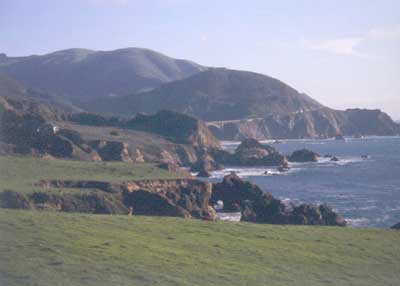 |
|---|
This very allusiveness adds to the appeal of the area, I think. In fact, I'm not sure whether it's more appropriate to say we were “in” Big Sur, “at” Big Sur, or merely “passing through” Big Sur. We stayed at the lodge in Pfeiffer-Big Sur State Park, and we saw absolutely no one on the grounds during our visit. We hiked through the redwoods to Pfeiffer Falls, and up to the meadows above the trees, in utter solitude. Many of the beaches were all but deserted too. There were a number of campers and hikers at Andrew Molera Beach, where the river was swollen from recent rains, the bridges were out, and the main path to the beach was impassable. We followed the trail through the campground, with other vacationing families behind and ahead of us on the trail, past the cedar shack that's among the oldest buildings in the county, and through a eucalyptus grove to the headlands above the beach.
Later that day we spent a few hours at Point Lobos, twenty miles up the coast. This glamour spot—a rocky peninsula covered with cypress trees—is truly spectacular in every way, with harbor seals lounging here and there, sea otters frolicing amid the floating islands of seaweed, and sea lions barking from the archipelago of rocky islands that lies just off shore; tide pools, mule deer in the fields, oyster catchers and brown pelicans on the rocks, and the relentless sound of wind and surf everywhere. Occasionally we spotted gray whales blowing puffs of water far out to sea.
But Point Lobos is too close to town, and too dazzling in its offerings, to be considered anywhere near the elusive heart of Big Sur. You're more likely to feel that pulse on the highway that hugs the hills hundreds of feet above the water, or on the beaches that lie down unmarked roads.
One stretch of highway in particular, just south of the hamlet of Big Sur itself, seems to encapsulate the various aspects of the area.
On the one hand you have Deetjen's, an old resort tucked into the redwoods on the hillside, which consists of small cabins built from scrap lumber in the 1870s by a Norwegian settler. The environs are cool and dark, but the restaurant that stands alongside the highway is cozy and the food they serve is excellent.
A mile or less down the way Nepenthe stands proudly on the seaward side of the highway. The original cottage was given by Orson Welles as a gift to his then-wife Rita Hayworth. It's long since been turned into a swanky restaurant nightclub, with lavish mosaics and a spectacular view south down the coast.
In between the two, tucked back into the woods, is the Henry Miller Memorial Library. This museum/bookshop/performance space—formerly the home of one of Miller's friends and devotees, the naive painter Emile White—is stocked with a small but choice collection of books relating to the area, as well as a number of books by Miller on all subjects, alongside a smattering of books by various Beats. Paintings by Miller and White hang from the dark, rough-hewn walls; and there are also framed covers from fading issues of Life Magazine dating from the fifties, that carry articles about the counter-culture life at Big Sur—the kind of thing Miller writes about himself in his essay-memoir Big Sur and the Oranges of Hieronymus Bosch (1957).
We got to talking to the tall, square-jawed man who ran the shop—no one else was around—and when we told him we were from Minnesota, he came back with that lilting stereotypical Scandahoovian “Min-e-so-ta, there are lots of Swedes there.” I hate that remark—though I find it instructive to analyze my own sense of insult, which must be a faint echo of what more deeply disenfranchised minorities experience frequently. The man redeemed himself immediately, however, by adding, “I'm Swedish myself.”
“I'm Swedish too,” I relied.
“What's your name,” he asked.
“Well, in Sweden they'd probably say Tor-een.”
He stared at me in evident disbelief, and I got the impression he was about to start pulling my leg, though the direction remained unclear.
“My name is Toren too,” he said. “That's a very rare name, even in Sweden. We're probably related.”
He seemed to be genuinely moved and excited by this discovery. But the more we talked, the more convinced he became that we were not, in fact, related, and when I told him my ancestors came from Smaland, he repressed a smile—as if Smaland were even more gauche than Minnesota.
“People from Smaland are known for their independent spirit,” he said, though I got the impression that what he was really trying to say was that people from Smaland were known to be fools and hicks. He asked me why my ancestors left. I had no idea.
“People left Sweden for one of two reasons. They were very poor—but just rich enough to buy a ticket abroad. Or they left for religious reasons.” My ancestors were devote members of the Swedish Covenant Church, so that probably had something to do with it.
We asked Magnus how long he'd been in the area (twenty years) and how it had changed during that time. He paused to consider the question, measuring his phrases, though I'm sure he hears it regularly.
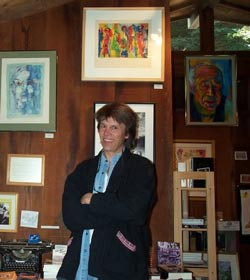 |
|---|
“The area has changed demographically,” he said finally. “Rich people aren't better or worse than ordinary people, necessarily...it's just that they usually have three or four houses—the Bahamas, New York, Antibes—so they don't spend the same amount of time here that the regulars do. And real estate has become so expensive that its very difficult for the craftsmen and trades people who used to make up the core of the community to continue living here. The best and finest segment of the hippy folk—the ones that survived, if you know what I mean. There are still properties around, but they're damp, cold, unhealthy. Some people live in trailers behind their shops.”
Magnus himself was working as a commercial fisherman when he first caught sight of Big Sur. He fell in love with the place, and never left. For many years now he's been the director of the Henry Miller Library, which also serves as the cultural center for the region. He organizes musical events and readings—including a recent show by rock icon Patti Smith—and writes and performs music himself. He's developing a sideline taking photographs at parties, then packaging them by computer to offer to guests.
“I'll bet you get invited to some swell parties,” I said. He gave me a look that spoke volumes.
It occurred to me, as we made our way back through the redwoods to our cabin at Pfeiffer-Big Sur State Park, that during his long sojourn in California Toren the Swede has retained just about all the qualities that drew him to Big Sur in the first place—a sensitivity to the power and beauty of nature, an interest in personal expression, a commitment to community involvement, and a good heart.